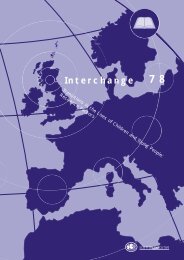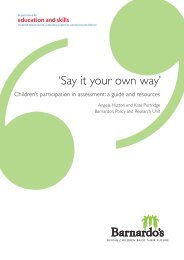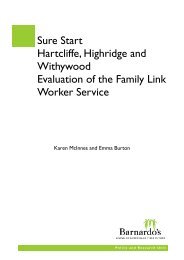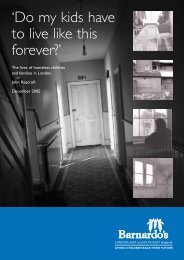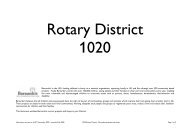Splintered Lives - Barnardo's
Splintered Lives - Barnardo's
Splintered Lives - Barnardo's
You also want an ePaper? Increase the reach of your titles
YUMPU automatically turns print PDFs into web optimized ePapers that Google loves.
PAGE 30<br />
chapter<br />
7<br />
Public records, research and other evidence<br />
The Council of Europe (1991) note the paucity of reliable data on sexual exploitation and<br />
Michael Hames commented: "We don't actually know how many children are being<br />
abused in any category of crime",<br />
As with all forms of child abuse some evidence on reported cases does exist, but a key<br />
problem here is that where sexual exploitation is known about from the outset they<br />
tend to be dealt with only by the police. Thus most of these cases never appear in child<br />
protection/child abuse figures compiled by yearly by the Department of Health. Bernard<br />
Gallagher, researcher on an ESRC funded survey of organised abuse, confirmed this:<br />
their detailed surveys of police and social work case files in eight areas revealed limited<br />
evidence of sexual exploitation, but it was made clear formally and informally that such<br />
cases remained with serious crime, or vice, and rarely involved child protection teams.<br />
We have been able to pull together some evidence on reported cases, but view this as<br />
both limited and inadequate.<br />
In England and Wales 22 cases involving child pornography were prosecuted in 1985,24<br />
convictions resulted (including cases begun in 1984); in 1986 10 prosecutions, 11<br />
convictions were recorded (ICCB, 1988). This suggests that where cases are prosecuted<br />
they are usually successful, probably because they invariably involve 'material<br />
evidence' in the form of photographs/films/videos and presumably more recently<br />
computer discs, and possession of child pornography is now itself an offence.<br />
Evidence is also collated of prostitution offenses, usually resulting a caution, where the<br />
person concerned is under 16, they were:<br />
Year Number of offenses<br />
1984 32<br />
1985 44<br />
1986 37<br />
1987 27<br />
During the same period (1984-7) 2400 offenses involving 17-20 year odds were<br />
recorded.<br />
More recent figures compiled by The Children's Society (1994, re-calculated for this<br />
report below in Tables One to Three) reveal that in 1991 five of 19 police authorities<br />
accounted for nearly three quarters of cautions of girls under 16: Cleveland, Manchester,<br />
Metropolitan, West Yorkshire, West Midlands. Whilst this could simply be the outcome<br />
of large urban areas being particular foci for young runaways, the figures do show both






